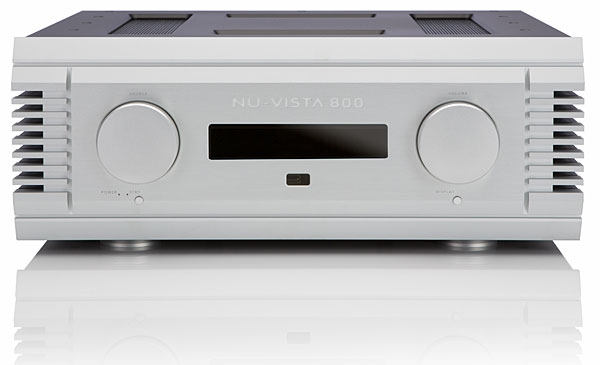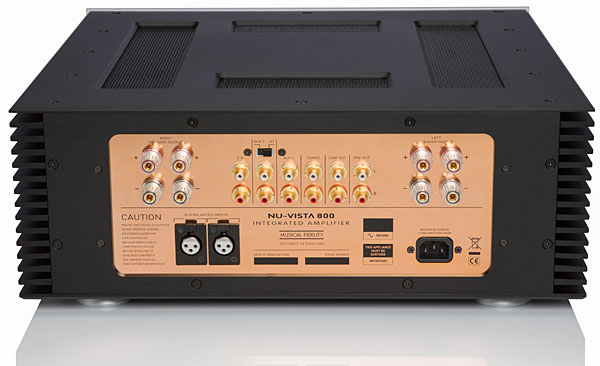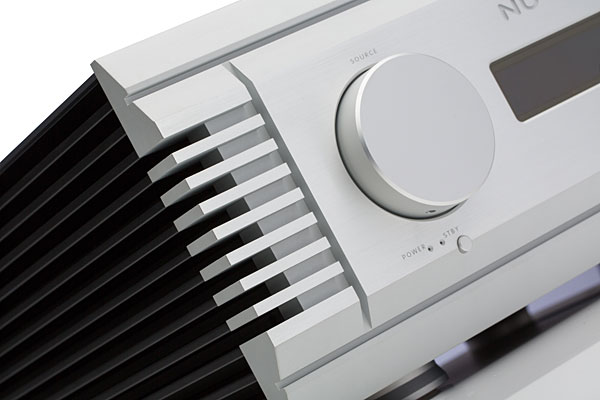| Columns Retired Columns & Blogs |
Musical Fidelity Nu-Vista 800 integrated amplifier

Nuvistors—miniature, small-signal, vacuum tubes made of metal and ceramic—were introduced by RCA in 1959, at the dawn of the transistor revolution. RCA used them throughout the 1960s in its New Vista line of television sets, mostly in the tuner section. But by the early 1970s, solid-state devices had all but replaced tubes, nuvistors included (with a few notable exceptions). Ampex based the electronics of its well-regarded, late-'60s MR-70 open-reel tape deck on nuvistors, which were also used in microphone preamplifiers—in both cases for their very low noise and reputation for reliability and long life. For a time, Conrad-Johnson used them as well. While nuvistors may seem exotic today, they're hardly rare. On eBay you can find for sale hundreds if not thousands of used and new-old stock (NOS) nuvistors, as well as nuvistor sockets, without which the tubes are less easy to implement. (But they can be, and often are, hard-wired into a circuit.)
Musical Fidelity, under the direction of owner and frustrated clarinetist Antony Michaelson, has for decades designed and manufactured its Nu-Vista line of nuvistor-based components: preamplifiers, power amplifiers, integrated amplifiers, and disc players. While MF hasn't cornered the market on the tiny tubes and sockets, it has amassed enough of them to continue designing and making new models based on the tube, and to support owners of their older models, should any nuvistors fail. In my experience, nuvistors rarely fail—they're said to provide 100,000 hours of use. I've owned numerous Nu-Vista models, including the curvaceous, dual-chassis 300 power amplifier and matching preamp, and no nuvistor in any of them has failed or gone noisy.
Musical Fidelity's new Nu-Vista 800 integrated amplifier ($12,999) outputs 330Wpc into 8 ohms. It's hefty, solidly constructed, weighs 86 lbs, and is the first model from a new, young design team brought in after a company shake-up. The 800 combines in one chassis a preamplifier with four JAN 7586 nuvistor triodes—two per channel—in a buffer configuration, and a dual-mono solid-state power amplifier based on surface-mount printed circuit boards and five pairs of bipolar output transistors per channel. Like all MF products these days, the Nu-Vista 800 is built in Taiwan.
The Nu-Vista 800's exterior design extends from the cosmetics of Musical Fidelity's former flagship amplifier, the Titan monoblock (a pair of which I also owned). But from every angle and vantage point, the Nu-Vista 800 is by far MF's best-looking product, ever. And while the older products were usually never less than well turned out, the 800's fit'n'finish and attention to detail set new standards for the company.
Details
The Nu-Vista 800 has five line-level inputs: four single-ended (RCA)—labeled CD, Aux 1/HT, Aux 2, and Tuner—and one balanced (XLR), which is labeled Balanced. Associated with the Aux 1/HT input is a rear-panel switch that bypasses the volume control.

Though the Nu-Vista 800 is an integrated amplifier, it has two sets of line-level outputs: one fixed-level, for use in analog recording or with a headphone amplifier, and one variable, for use in biamping or with a powered subwoofer. There are also two pairs per channel of generously spaced speaker terminals that can act as banana jacks or binding posts. The extra terminals aren't for a second pair of loudspeakers, but are included to aid in bi-wiring.
On the left of the front panel is a large Source selector knob; on the right is a matching Volume knob. Between them is a green LED screen that displays the selected source and the volume level, and below that is the IR receiver window. Directly below the Source knob are a small On/Standby button and two LEDs: blue for On, amber for Standby. Directly below the Volume knob is a small Display button.

Most users will no doubt operate the Nu-Vista 800 using its remote control. Milled from aluminum and finished with a satin sheen, it's heavy in the hand, with buttons for Source, Volume Up/Down, and Mute. There's also a Display button—which doubles the one on the amp's front panel—for cycling through eight modes of Illumination: a Musical Fidelity specialty. Not only the LED screen but also the Nu-Vista 800's cool undercarriage lighting and its illuminated nuvistor sockets—the latter visible through an opening on the top of the amp—can be powered up or down in virtually any combination. The Nu-Vista 800 can also be run without Illumination.
Antony Michaelson visited me, bringing with him a set of graphs of the Nu-Vista 800's measured performance. If they match John Atkinson's measurements, they'll demonstrate an integrated amplifier of ultralow distortion and wide bandwidth. I was more interested in the sound.
Setup
Reviewing an integrated amplifier in my system presents logistical difficulties: Putting it on the rack with my source components and preamp requires speaker cables of greater than 20' length, which is longer than ideal. So in my listening room, the Nu-Vista 800 sat on four Stillpoints Ultra feet, atop my Shunyata Hydra Triton AC distributor, which itself sat atop a Black Diamond Racing platform. For digital source material, I used an 18' balanced pair of Wireworld Eclipse Platinum 7 interconnects to go from my Simaudio Moon Evolution 650D DAC-transport to the Nu-Vista 800's balanced inputs.
For vinyl, Antony Michaelson was okay with running my darTZeel NHB-18NS preamp into one of the Nu-Vista 800's pairs of unbalanced inputs, using a different, single-ended 18' pair of Wireworld Eclipse Platinum 7 interconnects. I used the volume controls of both the darTZeel pre and the Musical Fidelity integrated, both to optimize the vinyl setup and to allow easy, level-matched switching between the direct and preamp-supplemented connections, to assess any sonic differences between them.
Digital listening
Every time a manufacturer visits my listening room to help install his or her product, the same thing happens: The product is inserted in the system. I play some music. The sound pours forth. And the manufacturer utters a self-satisfied "Well! There you go!" And then I'm supposed to then say, "Damn! You're right! This is the best thing since French toast!"
- Log in or register to post comments




































